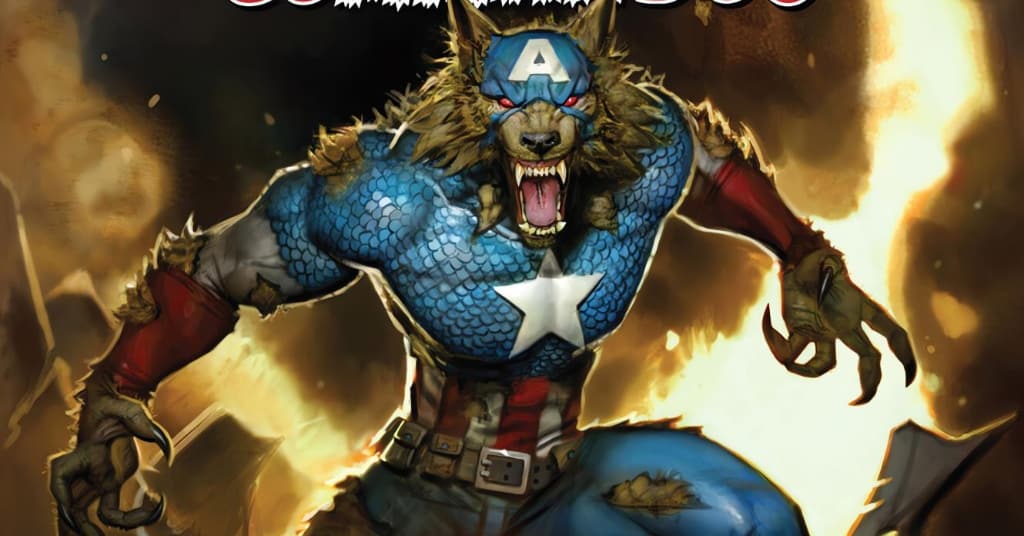Capwolf and the Howling Commandos #1
Recap
When Captain America is transformed into a werewolf on the front lines of World War II, he’ll need the help of the Howling Commandos to take down a band of Nazi cultists who intend to use supernatural forces to turn the tide of battle. But can Cap control the skeptical, jaded Commandos when he can barely control himself?
Review
Capwolf & the Howling Commandos #1 – written by Stephanie Phillips with art by Carlos Magno, colors by Espen Grundetjern, and lettering from VC’s Travis Lanham – delivers a twisted tale of magic and monsters set against the backdrop of World War II. The central premise of the series sees Captain America turning into his werewolf form decades early while serving in the fight against the Nazis in Europe.
This first issue works to establish the context, as Captain America joins up with Nick Fury and the Howling Commands. The opening half of the story sees Cap providing support for the team as they fight their way through a German-occupied France. Pinned down, the Commandos are prepared to lay down their life before Cap arrives. Amid the fight, Fury is injured, a fact that works to set up the second mission of the book.
Captain America is asked to lead the team in an attack on Wolfsschanze, a fortified German bunker developed by Hitler. The Commands, represented by Dum Dum Duggan, chafe at the idea of Captain America leading the team, seeing the hero as nothing more than a walking piece of propaganda. The conflict flashes as the team departs for their mission, following through enemy lines as a pack of werewolves attack, wounding Captain America in a manner that results in the titular Capwolf.
Phillips delivers a consistent, engaging script that doesn’t break the mold, but delivers a meat and potato story. The premise of tying the mystical with the horrors of World War II is not a new idea by a long shot, but the execution is an interesting spin on the notion of Cap as a symbol. The conflict that results from Cap’s appearance around the regular soldiers is a departure from the typical awestruck expression of most enlisted fighters. It’s an interesting dichotomy of the concept of a symbol working too well, creating a dissonance between the public and those fighting in the trenches.
The originality and compelling elements start and end with that fact. For the remainder of the book, the plot and writing comes off as a checklist of tropes. Gruff soldiers posturing, creepy, nondescript European forests, and lingering magics fill the pages of this issue, and all feel like items in a series rather than elements of a captivating narrative. Phillips uses the familiar to create a baseline for this alternate universe story but never steps outside the circle of cliche to deliver an original concept.
That sense of sameness originates from Magno’s linework, which reads as consistent but bland. Faces and bodies feel copied and pasted across the various panels, with all the male characters having the same larger, dense foreheads. The repetition of anatomy does not feel like a deliberate choice by the creative team, instead works as a method of consistency that gets the book out on time. That sense of familiarity leads to a flat tone, with bland visuals that can only pop in one or two places.
In contrast to the bland layouts and compositions throughout the issue, the book excels when the werewolves hit the page. Magno’s pencils feel like they were born to draw vicious beasts attacking the soldiers, and the wolves carry themselves with a weight that sells the horror of the attack. The little details, like the mass of slobbering fangs and claws, make the pages pop and add to the terror of these beasts. The battle between the wolf and cap especially is a stunning few pages, as Magno’s simple layouts maximize clarity and put the pulpy action to the forefront. When Capwolf’s form erupts at the end of the issue, something clicks into place and transforms the subdued into the exciting.
Much of that tonal shift comes from the splash of coloring on the final page, with a veiny red background creating a striking contrast to the blue of Cap’s uniform and the brown of the wolf fur. Grundetjern’s colors feel subdued everywhere in the book but this last moment finally gives a sense of terror to an otherwise straightforward war story. The muted tones of the book do it no favors, undercutting the sense of the macabre and monstrous by focusing on the war aesthetic.
Final Thoughts
Capwolf & the Howling Commandos #1 is off to a rocky start with a heavy focus on the familiarity of war and continuity. Only in the final pages of the issue does the story shift gears and start to deliver on the premise. All elements of the book, from Phillips’s writing to Magno’s art, and even Grundetjern’s coloring, feel like the safest choices, which gives the book a subdued reading experience. Only when the mystical element is interjected does the book transform into something worth reading. The hook is strong enough to warrant reading the second issue, but unless the story makes a harsh metamorphosis, it will remain just another disposable entry into the canon of supernatural World War II stories.
Capwolf & the Howling Commandos #1: Bland Moon Rising
- Writing - 6/106/10
- Storyline - 6/106/10
- Art - 6/106/10
- Color - 6/106/10
- Cover Art - 6/106/10
